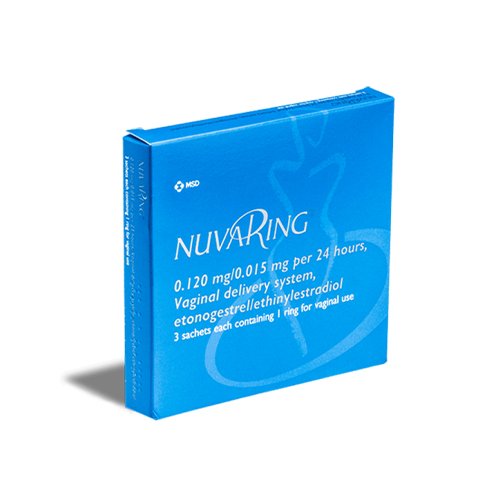What is Nuvaring?
How does it work?
What are the benefits of taking it?
How do I use it and its dosage?
You can put on and take off the NuvaRing yourself. Your doctor will tell you when to start using it for the first time. The vaginal ring must be inserted on the correct day of your monthly cycle and remain in the vagina for 3 weeks in a row. Check regularly that NuvaRing is in your vagina (for example, before and after sexual intercourse) to ensure that you are protected against pregnancy. After the third week, remove NuvaRing and allow a week off. You will normally have your monthly period or period during this ringless break.
While you are using NuvaRing, you should not use some female barrier methods of birth control, such as the vaginal diaphragm, cervical cap, or female condom. These barrier methods of contraception should not be used as a reinforcement method of birth control as NuvaRing may interfere with the correct positioning and positioning of the diaphragm, cervical cap or female condom. However, you can use a male condom as an additional barrier method of contraception.
How to put on and take off the NuvaRing
- Before putting on the ring, check that it is not expired.
- Wash your hands before putting on or taking off the ring.
- Choose the position that is most comfortable for you to insert it, for example standing with one leg raised up, squatting or lying down.
- Remove NuvaRing from its envelope.
- Hold the ring between your thumb and index finger, press opposite sides, and insert the ring into your vagina. Alternatively, you may choose to use the NuvaRing Applicator to help you insert the ring. When NuvaRing is in place you should not notice anything. If you feel uncomfortable, gently change the position of the NuvaRing (for example, push the ring a little further into the vagina) until you feel comfortable. The exact position of the ring inside the vagina is not important.
- After 3 weeks, remove the NuvaRing from your vagina. You can do this by hooking the ring with your index finger or by grasping it with your fingers and pulling it out. In case you cannot remove the ring despite having located it, contact your doctor.
- Dispose of the used ring with your normal household garbage, preferably in its envelope. Do not flush NuvaRing down the toilet.
Side effects & precautions
Like all medicines, NuvaRing can cause side effects, although not everyone gets them. If you experience any side effects, especially if they are severe and persistent, or have any health changes that you think may be due to NuvaRing, consult your doctor.
All women who take combined hormonal contraceptives are at increased risk of developing blood clots in the veins (venous thromboembolism (VTE)) or blood clots in the arteries (arterial thromboembolism (ASD)). For more detailed information on the different risks of taking combined hormonal contraceptives.
If you are allergic to any of the ingredients of NuvaRing (hypersensitivity), you may have the following symptoms (frequency not known): angioedema and/or anaphylaxis [swelling of the face, lips, tongue and/or throat and/or difficulty swallowing] or hives, along with breathing difficulties. If this happens, remove NuvaRing and contact your doctor immediately.
NuvaRing users have reported the following side effects:
Common: may affect up to 1 in 10 women.
- abdominal pain, discomfort (nausea)
- yeast infection of the vagina (similar to oral candidiasis), vaginal discomfort due to the ring, genital itching, vaginal discharge
- headache or migraine, depressed mood, less sex drive
- breast pain, pelvic pain, painful menstruation
- acne
- weight gain
- ring ejection
Uncommon: may affect up to 1 in 100 women.
- visual disturbances, dizziness
- swollen abdomen, vomiting, diarrhoea, or constipation
- feeling tired, upset or irritable, mood swings, changes in mood
- fluid retention in the body (oedema)
- urine or bladder infection
- pain when urinating; urge to urinate Need to urinate more frequently
- problems with intercourse such as pain, bleeding, or the partner noticing the ring
- Elevation of blood pressure
- increased appetite
- back pain, muscle cramps, pain in the legs or arms
- less skin sensitivity
- tension or pain in the breasts or enlargement; fibrocystic breast disease (cysts in the breasts that can become swollen or painful)
- inflammation of the cervix, polyps growing on the cervix, shifting of tissue inside the cervix to the outside (ectropion)
- changes in menstrual period (more intense, long, irregular or disappearing), discomfort in the pelvis, premenstrual syndrome, uterine cramps
- A vaginal infection (fungal or bacteria), burning, odour, pain, discomfort, or dryness of the vagina or vulva
- hair loss, eczema, itching, rash, or hot flashes
Rare: may affect up to 1 in 1,000 women.
harmful blood clots in a vein or artery, for example:
- in one leg or foot (i.e. DVT)
- in a lung (i.e. EP)
- heart attack
- ictus
- mild stroke or temporary symptoms similar to those of a stroke called a transient ischemic attack (TIA)
- blood clots in the liver, stomach/intestine, kidneys, or eye.







Reviews
There are no reviews yet.